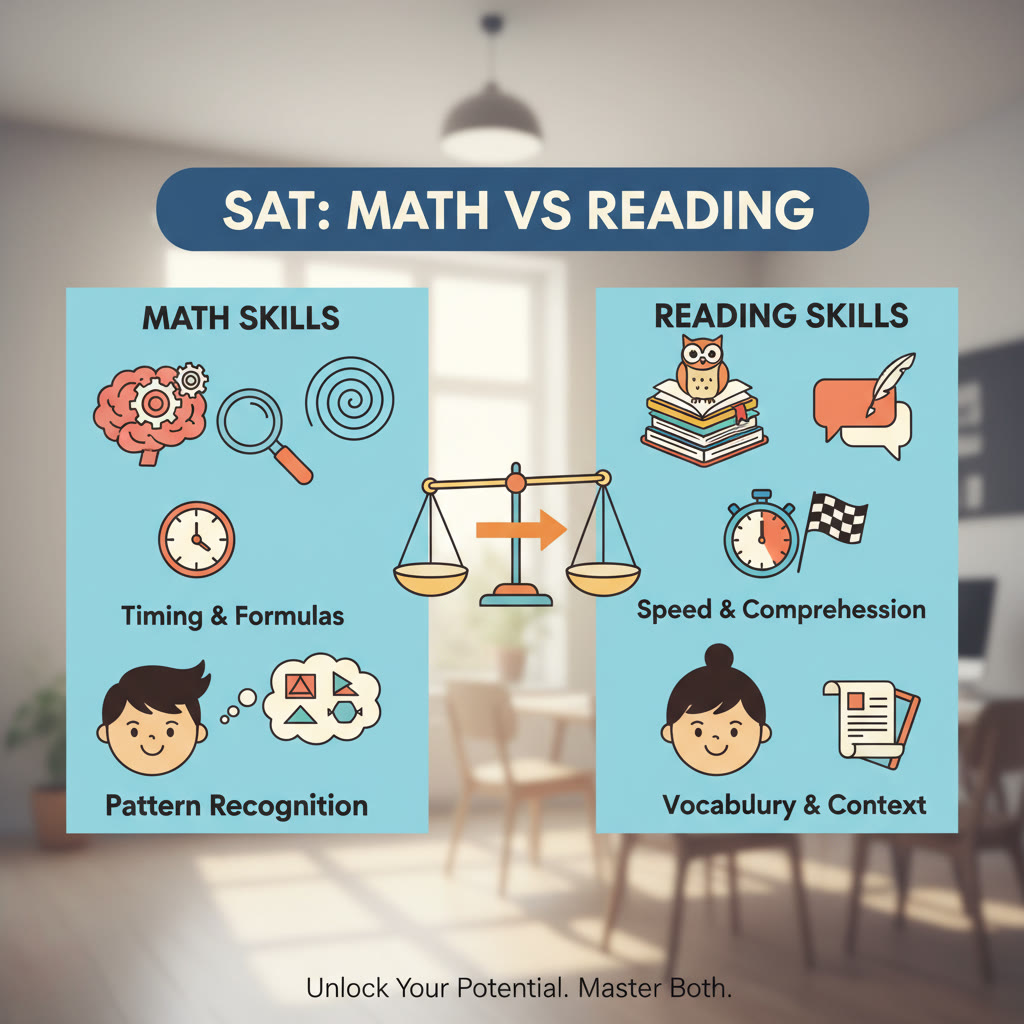Why Some Students Score Better in SAT Math Than Reading — and Why That’s Okay
It happens in classrooms, at kitchen tables, and on practice test spreadsheets: a student posts a strong score in SAT Math but trails in SAT Reading, or the reverse. When you stare at those numbers, it’s tempting to think there’s a single reason — ‘I’m bad at reading’ or ‘I’m not a math person.’ The truth is more interesting and useful. Score gaps between SAT Math and Reading usually reflect a mixture of test design, prior learning, cognitive skills, language experience, mindset, and study habits. Understanding those layers is the first step toward closing the gap.
How big are these gaps, really?
First, let’s be realistic. Colleges look at the overall picture, but individual section scores matter. A 50–100 point difference between Math and Evidence-Based Reading and Writing (ERW) is common. Larger gaps are less common but entirely fixable with targeted practice. What looks like a permanent talent difference is often a combination of specific weaknesses and uneven practice.
What the SAT Tests — and How That Shapes Score Differences
The SAT is not a pure IQ test. It is a carefully engineered assessment that measures distinct skills under time pressure. Knowing which skills each section emphasizes helps you see why gaps appear.
Math is structured, procedural, and cumulative
SAT Math rewards clarity of procedure: set up an equation, manipulate expressions, apply a formula, and check your work. Many problems follow patterns. Students who have had steady exposure to algebra and geometry learn to recognize those structures. Because math problems often have one correct approach, practice yields predictable improvement.
Reading is interpretive, contextual, and diverse
SAT Reading tests comprehension, inference, and analysis across a variety of passages — literary, historical, social science, and natural science. There’s more ambiguity by design. Correct answers depend on subtle cues in phrasing, and sometimes multiple choices look plausible. That requires experience with dense texts, strong vocabulary, and the ability to track an author’s argument — skills that develop more slowly and unevenly than procedural math techniques.
Timing differences matter
The timing structure of each section interacts with student strengths. Rapid arithmetic or pattern recognition can be faster to execute than careful passage analysis. Conversely, a methodical reader who dislikes the pressure of quick computations may see the opposite gap. Time pressure amplifies modest skill differences into significant score gaps.
Sources of Score Gaps: Root Causes and Real Examples
Let’s dig into the common causes, paired with examples you might recognize.
1. Curriculum exposure and classroom experience
Students who attend schools with strong math programs but less emphasis on close reading or humanities often show higher Math than Reading scores. Conversely, avid readers in liberal-arts environments sometimes outperform on Reading. Example: a student from a STEM-focused magnet school may have extensive problem-solving practice, while their exposure to dense argumentative texts is limited.
2. Language proficiency and vocabulary
For multilingual students or those who learned English later, Reading can be disproportionately difficult even if raw reasoning skills are strong. Vocabulary and idiomatic expressions are gatekeepers for comprehension. Meanwhile, math problems with dense wording can trip up these same students, but often the procedural nature of math can be more forgiving once they understand the question.
3. Cognitive strengths and learning styles
Some brains prefer abstract symbols and spatial reasoning; others prefer narrative, nuance, and context. These cognitive preferences aren’t fixed weaknesses — they’re directions for targeted practice. A pattern recognizer may accelerate in Math with practice, while a nuanced thinker can be coached to sharpen timing and inference skills in Reading.
4. Test-taking strategies and metacognition
Knowing how to approach the test — when to skip, how to eliminate choices, how to check work — is a skill in itself. Students who have been trained in math strategies like back-solving or plugging in numbers might see quick gains in Math. Those who haven’t been taught active reading strategies (annotating, summarizing main ideas) may underperform in Reading despite strong general comprehension.
5. Anxiety and confidence
Nervousness affects attention and working memory. Some students freeze on math problems because one tricky question undermines confidence; others read too quickly in the hopes of finishing and lose accuracy. Anxiety often shows up asymmetrically — affecting one section more than the other — and becomes a feedback loop unless addressed.
6. Access to resources
Practice tests, targeted prep materials, and tutoring make a big difference. Students with access to skilled instruction and adaptive feedback close gaps faster. This is one place where tailored support — like one-on-one tutoring and AI-driven insights — can accelerate improvement by pinpointing the most efficient next steps.
Comparing the Skill Sets Visually
Here’s a simple way to see how the two sections value different skills and what to focus on when one outpaces the other.
| Skill Area | SAT Math Emphasis | SAT Reading Emphasis |
|---|---|---|
| Pattern Recognition | High | Low |
| Procedural Fluency | High | Medium |
| Vocabulary/Context | Low | High |
| Inference/Argument Analysis | Low | High |
| Time Pressure | High | High |
| Multiple Steps vs Ambiguity | Multiple Steps | Ambiguity |
What the table tells you
If your Math is higher: you probably have strong pattern recognition and procedural fluency. If your Reading is higher: you probably excel at inference, vocabulary, and tracking arguments. Both patterns are strengths to leverage.
Real Student Scenarios (Short Case Studies)
To make this concrete, here are three short, realistic scenarios and what helped each student close their gap.
Case 1: Maya — strong math, weak reading
Maya earned a 770 in Math but a 640 in ERW on a practice test. She attended a school with excellent math instruction but had little guided practice with dense nonfiction. Her action plan:
- Daily 30-minute active reading practice using science and history passages.
- Weekly vocabulary in context practice rather than memorization of long lists.
- One-on-one coaching to learn annotation and evidence-tracking strategies.
Result: Incremental progress over 8 weeks turned the 130-point gap into a 30-point gap, with gains in inference and accuracy.
Case 2: Jordan — strong reading, shaky math
Jordan scored 740 in ERW and 620 in Math. He understood concepts but made careless algebraic errors. His plan focused on:
- Targeted math drills emphasizing algebraic manipulation and error-checking routines.
- Timed sections to improve fluency without sacrificing accuracy.
- Concept-reinforcement sessions with worked examples and visualization techniques.
Result: Over two months, Jordan reduced careless mistakes and improved speed, narrowing the gap by 80 points.
Case 3: Amina — language learner with balanced skills but limited resources
Amina’s baseline was 700 Math and 680 ERW. She had potential but lacked tailored feedback and consistent strategies. Her plan included:
- Structured study schedule with mixed practice sections to build stamina.
- Personalized tutor sessions to diagnose recurring errors.
- Use of adaptive practice tools to focus on weakest question types.
Result: With targeted support, Amina gained the confidence to convert practice improvements into test-day performance, closing the gap and improving overall score.
At-a-Glance: Common Causes and Practical Fixes
| Cause | Why It Creates a Gap | Quick Fix |
|---|---|---|
| Uneven curriculum | More practice in one domain builds skill faster | Schedule daily focused practice for weaker section |
| Vocabulary/Language proficiency | Limits comprehension of passages | Contextual vocabulary + reading diverse genres |
| Test anxiety | Impairs time management and working memory | Simulate test conditions + relaxation techniques |
| Poor strategies | Lost points despite content knowledge | Teach elimination, back-solving, annotation |
| Lack of feedback | Repeating the same mistakes | One-on-one tutoring and performance analytics |
Actionable, Step-by-Step Plan to Close Your Gap
Closing a section gap is usually a focused, measurable process. Here’s a plan you can adapt to your timeline — whether you have two months or six.
Phase 1: Diagnose (1–2 weeks)
- Take a full, timed practice SAT to identify specific question types that cause trouble.
- Track errors by category: algebra, geometry, data analysis, command of evidence, inference, sentence structure, vocabulary-in-context.
- Note timing patterns: Which passages or problem sets did you rush? Where did you get stuck?
Phase 2: Targeted practice (4–8 weeks)
- Prioritize the weakest categories first. For Reading, practice paired passages and evidence questions. For Math, drill multi-step algebra and problem translation.
- Use mixed practice sets to build stamina under realistic timing.
- Keep a small error journal. Write down why each mistake happened and how to avoid it next time.
Phase 3: Strategy and simulation (2–4 weeks)
- Refine strategies: passage annotation, elimination techniques, plugging in numbers, back-solving, time checkpoints per passage/block.
- Take at least two full practice tests under simulated test-day conditions each week.
- Analyze every practice test: look for creeping patterns like careless errors or slow sections.
Phase 4: Polish and test readiness (1–2 weeks)
- Lighten workload to avoid burnout; focus on accuracy and confidence-building drills.
- Practice relaxation routines and test-day logistics to reduce anxiety.
- Review high-yield formulas, grammar rules, and vocabulary in context rather than isolated lists.
Tools and Techniques That Actually Help
Some tools are flashy but not useful. Here are approaches that give consistent returns.
- Deliberate practice: short, focused sessions on the exact question type where you lose points.
- Active reading: annotate topic sentences, track the author’s purpose, and predict the next paragraph.
- Worked examples: for hard math problems, study several complete solutions to see efficient approaches.
- Opposite-style practice: if Math is your strength, practice reading under timed pressure to train different mental muscles; vice versa if Reading is your strength.
- Adaptive feedback: use tutors or platforms that identify your weakest subskills and prioritize them.

How Personalized Tutoring Fits Naturally Into the Fix
Personalized tutoring is not magic, but it’s one of the most efficient ways to close a gap because it short-circuits trial-and-error. When the tutor tailors the plan to your specific error patterns, you practice only what’s necessary.
What targeted tutoring does better than solo practice
- Diagnoses root causes quickly instead of treating surface symptoms.
- Provides immediate feedback so you don’t repeat the same mistakes.
- Introduces strategies that match your learning style — for example, visualization for algebraic manipulation or structure-mapping for passage analysis.
- Monitors progress and adjusts the plan so practice time is always high-value.
For students who want a mix of human guidance and technology, Sparkl’s personalized tutoring model can fit naturally into this workflow. With one-on-one guidance, tailored study plans, expert tutors, and AI-driven insights, Sparkl helps pinpoint whether a gap is about time management, conceptual understanding, or test strategy — then builds a plan that targets that cause. It’s not about promoting a service; it’s about acknowledging that targeted, adaptive support speeds progress.
How to Build a Weekly Study Schedule That Closes Gaps
Here’s a practical weekly template you can adjust based on how much time you have.
| Day | Focus | Duration |
|---|---|---|
| Monday | Targeted Math drills on weakest topic | 60 minutes |
| Tuesday | Timed Reading passage practice + vocab in context | 60 minutes |
| Wednesday | Mixed practice set (half Math, half Reading) | 90 minutes |
| Thursday | Strategy session (tutor or self-review of errors) | 45–60 minutes |
| Friday | Full timed section PRATICE (alternate Math/Reading) | 60–90 minutes |
| Saturday | Full practice test every other week | 3–4 hours |
| Sunday | Light review + relaxation and mental prep | 30–45 minutes |
Notes on using the schedule
- Quality over quantity: 60 focused minutes beats 3 unfocused hours.
- Use timed mini-sprints to build stamina: 25 minutes on, 5 minutes off.
- Weekly reflection: write one page on what changed and what’s still hard.

Mindset and Long-Term Growth
Finally, remember that score gaps reflect uneven practice, not fixed fate. Treat the weaker section as an opportunity. Every hour you invest purposefully yields compounding returns: improved accuracy, faster pattern recognition, better stamina, and reduced anxiety. Celebrate small wins — faster pacing, fewer careless errors, clearer passage summaries — because they add up.
Confidence-building rituals
- Track progress with numbers and qualitative notes.
- Run a short pre-test routine: 3 deep breaths, a 60-second stretch, and a simple warm-up question you can solve confidently.
- Visualize handling the hardest question calmly. Practice the emotion as well as the skill.
Final Thoughts — Your Next Small Step
Gaps between SAT Math and Reading are normal and solvable. The smartest approach is diagnostic, targeted, and iterative: find the true cause, practice the right things, and get focused feedback. If one-on-one guidance fits your learning style, consider a tutoring program that delivers tailored study plans and uses data to drive decisions. Sparkl’s mix of expert tutors, tailored plans, and AI-driven insights is one effective way to accelerate progress, especially when you need pinpointed help.
Pick the one tiny action you’ll take today: a 30-minute focused practice session on the weakest question type, or a short strategy session to learn one new elimination method. Small, consistent actions produce big score changes over time. You don’t have to be equally strong in every area tomorrow — just stronger than you were yesterday.
Keep going
Your scores will reflect your best study habits, not your worst day. Find the pattern in your mistakes, practice that pattern away, and enjoy watching the numbers align. You’ve got this.











No Comments
Leave a comment Cancel